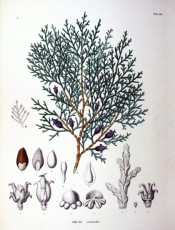Platycladus orientalis (L.f.) Franco
Fully-hardy, irregular or conical evergreen tree with erect branches and branchlets, very small, scale-like leaves, which often turn bronze in winter, and upright, flask-shaped, greyish female cones, to 2cm long. To 15m. [RHSE, Hortus, Hilliers’].
Horticultural & Botanical History
Introduced to Britain in 1752. [JD]. ‘Thuja orientalis L. Sp. P1. 1002. 1753. First described from Siberia. Chi’en K’ou, No. 3. Associated with Pinus, Juniperus, and Cotoneaster. Very common. A tree, up to 3 meters high, generally sprouting from old stumps. The wood is used as fuel and for furniture, buckets, tubs, etc.’ [Contributions from the United States national Herbarium vol.28, p.595/1942]. ‘This tree is very rarely planted in central and western China and we never met with a spontaneous specimen in our travels. It is probably a native of north-eastern China, Manchuria and Korea.’ [Plantae Wilsonianae vol.II, p.53/1916]. Flora Japonica Siebold & Zuccarini t.118/1870.
History at Camden Park
Listed only in the 1850 and 1857 catalogues [C.91/1850].
Notes
Published Aug 03, 2009 - 03:56 PM | Last updated Jul 16, 2010 - 05:13 PM

Platycladus orientalis (L.f.) Franco | Flora Japonica Siebold & Zuccarini t.118/1870 | Wikimedia Commons
| Family | Cupressaceae |
|---|---|
| Category | |
| Region of origin | China |
| Synonyms |
|
| Common Name | Chinese arbor-vitae, Biota |
| Name in the Camden Park Record | Thuja orientalis |
| Confidence level | high |